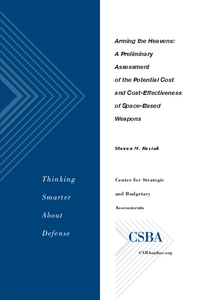
The United States is the world’s greatest economic and military power. Perhaps nothing demonstrates the extent of that dominance today better than the country’s preeminent role in space. The United States operates by far the most capable and costly network of satellites in the world.
Its extensive access to space provides significant economic benefits. It also gives the US military a critical edge over potential adversaries. The combination of US dominance in, and dependence on, space assets has led to both growing concerns about the vulnerability of those assets and calls for the United States to exploit further its existing advantages in space capabilities.
While space has been militarized for many years, it has not, at least as far as can be determined from unclassified sources, been weaponized. In other words, satellites have been used to provide intelligence, targeting and other support to terrestrial-based forces and weapons. However, to date, no country appears to have actually stationed weapons in space. Some analysts believe that the weaponization of space is inevitable and that the United States can and should move rapidly to acquire and field a range of space-based weapons. Others argue that the United States has more to lose than any other country if space is weaponized and that taking steps in this direction would lead to the worst of both worlds—yielding little or nothing in terms of military advantage, and sparking or accelerating an arms race in space that the United States should, instead, be seeking to avert or, at least, delay as long as possible.
Space-based weapons could, in theory, be used to carry out at least four different missions. Specifically, they could be used to:
- defend against ballistic missile strikes;
- attack terrestrial-based (i.e., surface-based and airborne) targets;
- destroy or disable enemy satellites; and
- protect US satellites, by intercepting enemy anti-satellite (ASAT) weapons.
The wisdom and feasibility of acquiring and deploying one or more of these kinds of space-based weapons can only be determined through an analysis that takes into account a broad range of strategic, operational, technological, political, and financial considerations. Of all of these factors, historically, the area that has received the least attention has been the financial costs—specifically, the funding requirements—that would be associated with the acquisition and support of space-based weapons.
This is understandable to some extent. Weapon system cost estimates can only be as accurate as the quality of information available concerning the system’s technical characteristics, overall system architecture and operational concept. In the case of space-based weapons, the quality of such information is typically poor. On the other hand, an analysis of space weapons that does not consider the system’s budgetary requirements is, at best, incomplete and, at worst, provides a misleading picture of the system’s potential cost-effectiveness.
In an effort to raise the level of debate concerning the wisdom and value of acquiring and deploying one or more of the four types of space-based weapons noted above, this report provides rough, order of- magnitude, estimates of the potential cost of acquiring and supporting such systems. Based on the cost estimates identified or derived in this report, and existing unclassified assessments of potential system effectiveness, this report also offers a range of tentative and preliminary conclusions concerning the likely cost-effectiveness of various types of
space-based weapons.
This analysis, which focuses on the potential for deploying space based weapons over the next 20 years, suggests five broad observations and conclusions:
- First, a constellation of space-based weapons designed to defend the United States against an attack with intercontinental ballistic missiles (ICBMs) would be extremely costly to acquire and support. Moreover, at least based on the technology likely to be available over the next twenty years, such a system would probably not prove to be a cost effective investment, especially when measured against the cost to a potential adversary of defeating such a system.
- Second, while space-based weapons intended to strike terrestrial based targets could, in some cases, cost substantially less to acquire and support than space-based ballistic missile defense systems, such weapons would likely prove more costly—and, in some instances, far more costly—than comparably effective terrestrial-based alternatives.
- Third, while space-based ASAT weapons would also generally be less costly to acquire and support than space-based ballistic missile defense systems, there does not appear to be a compelling need, on either cost or effectiveness grounds, to acquire a dedicated space-based ASAT capability—in part, because the US military already possesses or is acquiring a range of terrestrial-based weapons with significant inherent ASAT capabilities.
- Fourth, space-based defensive (“bodyguard”) satellites would, to a great extent, be indistinguishable from space-based ASAT weapons. Thus, such systems would likely have similar costs. In addition, their deployment would presumably have similar implications for sparking or accelerating an arms race in space. These weapons would also be incapable of protecting against some of the ASAT threats most likely to emerge in coming years. A more effective and cost-effective approach might be to rely on a range of passive countermeasures. Strengthening US space surveillance and tracking capabilities could also offer an important means of improving the security of US satellites.
- Fifth, although space-based weapons designed to strike terrestrial based targets, conduct ASAT attacks, or intercept enemy ASAT weapons appear to be neither necessary, nor, generally, as cost effective as terrestrial-based alternatives, in a few instances—unlike space-based ballistic missile defense systems—they appear to be relatively affordable and may even represent cost-effective options.In these cases, non-budgetary considerations, such the perceived strategic importance of the capability and the potential arms race implications of moving ahead with such a system, will have to play the dominant role in shaping programmatic and policy choices.
The following discussion provides a more in-depth summary of this report’s findings concerning each of the four types of space-based weapons that the US military might consider acquiring and deploying over the next two decades.

























